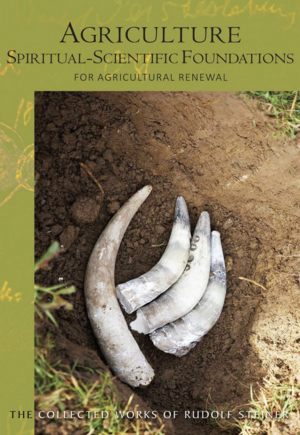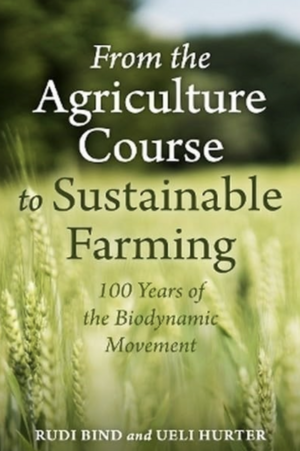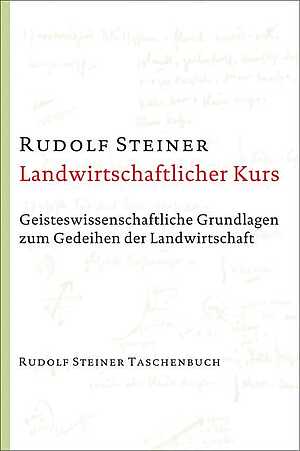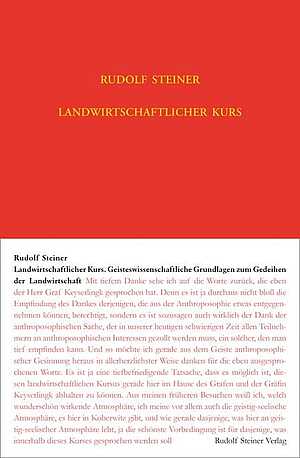The "Agricultural Course"
2024 marks the centenary of biodynamic agriculture. There will be many celebrations at international, national, regional and local level. Many of these events and many articles will refer to the "Agricultural Course" by Rudolf Steiner. On the one hand this expression refers to the book that is available on the market as GA 327 (as a hardback, a paperback and in many translations) and on the other it refers to the events in Koberwitz (now Kobierzyce, Poland) in June 1924.
Literatur
Agriculture
Spiritual-Scientific Foundations for Agricultural Renewal (The Collected Works of Rudolf Steiner, 327)
From the Agriculture Course to Sustainable Farming
100 Years of the Biodynamic Movement
"Landwirtschaftlicher Kurs" von Rudolf Steiner Taschenbuch 2022
Geisteswissenschaftliche Grundlagen zum Gedeihen der Landwirtschaft – Komplett überarbeitete Neuauflage nun auch als Taschenbuch
"Landwirtschaftlicher Kurs" von Rudolf Steiner
Geisteswissenschaftliche Grundlagen zum Gedeihen der Landwirtschaft – Komplett überarbeitete Neuauflage
Contact
News
Contents and red thread of the Agriculture Course
Ueli Hurter
The content of the Agriculture Course
First lecture
Rudolf Steiner began the first lecture by describing the difficult economic situation that agriculture finds itself in and said that as well as widening the horizons of agriculture itself, the development of a more healthy economy would also be an objective of the course. Right at the start he extends the context of what is relevant to agriculture to include the very circumference of the universe. He gives the example of the compass: The reason why the compass needle points to the north is not to be found within the compass but in its connection to the magnetic field of the whole earth. The plants are likewise connected with their entire planetary surroundings. The outer planets saturn, jupiter and mars work via siliceous substances upon the nutritional qualities of plants and the inner planets moon, venus and mercury via the calcium substances upon their reproductive power.
Second lecture
In the second lecture the concepts of the agricultural organism and individuality are introduced. In comparison to the human being the agricultural individuality is standing on its head, the soil being equated with the diaphragm. The functions of silica, calcium, clay and humus are described. The plants in all their diversity and differentiation stand fully within the cosmic rhythms of life. Animal life is partly emancipated from these influences and human life to an even greater extent,. Farm animals provide the manure which is so essential for developing the fertility of the site. The agricultural activities of soil, plant and animal are embedded within the polarities of above and below, sun and earth, cosmic and terrestrial etc.. The greater planetary structures of life are reflected in the lesser structures of life of the agricultural individuality. How the one corresponds with the other is described using examples including that of seed formation.
Third lecture
In the third lecture Rudolf Steiner speaks of the substances which make up protein, the bearer of life on the earth: Sulphur, carbon, oxygen, nitrogen hydrogen. These substances are the carriers or the physical manifestations of active spirit principles and they are described in the following way. Sulphur is the expression of spiritual forces that bring about materialisation, carbon is the bearer of creative and formative forces, oxygen is the carrier of life, nitrogen of the sensitivity-bearing forces and hydrogen has the task is to lead the material back into the spirit. These 'five sisters' are accompanied by calcium (craven desire) and silica (aloof gentleman). It can be sensed how spirit activity, qualities of soul and a living vitality are expressed within these processes.
Fourth lecture
The fourth lecture sees a transition from fundamental principles to practical indications. The working together of forces and substances is presented using a further example, nutrition. The perennial nature of trees is characterised and leads on to a consideration of compost and the processes of humus formation. The care of compost is addressed in a practical way. The way materials should be layered, how lime can be used, the kind of covering needed are spoken of very concretely. The listeners are encouraged to use their noses to determine whether the compost is developing in the right way. Then comes an encouragement to improve the manure still further. This leads to a description being given of the making and using of the horn manure preparation. A ground breaking innovation that was introduced in all its simplicity. The silica preparation is then briefly described. These two prparations supplement one another 'the one pushes from below, the other draws from above'. Horn manure preparation promotes a healthy soil and stronger rooting, horn silica enhances quality in the leaves, flowers and the formation of fruit.
Fifth lecture
In the fifth lecture the compost preparations are described. By way of introduction more basic information is shared on manuring. Readily soluble mineral fertilizer is not able to stimulate life, traditional farmyard manure manure should be treated in the best possible way and applied. Despite all this the farm still has a deficit of forces since more leave the farm with the harvest than can be replaced by purely natural organic processes. A balance can be regained by using dynamic measures, the preparations.
First the yarrow preparation is described: Yarrow flowers (Achilea millefolium) are gathered, moistened and placed the bladder of a stag. The filled bladders are hung up in the sun over summer and dug into the soil in the autumn.They spend the winter in the ground and in spring when they have been dug up they will have turned into a humus-like substance which can be stored until the manure, compost or liquid manure is ready to treat. Only very small homeopathic amounts are needed. This preparation supports the potassium process.
For the second preparation the flowers of chamomile (Matricaria chamomilla) are collected and dried. In autumn the flowers are moistened and filled into the small intestine of a slaughtered cow. These chamomile sausages are al so buried in the earth over winter and dug out in spring. Its use supports the calcium processes.
The third is the stinging nettle preparation. Nettles (Urtica dioica) are cut down just before flowering, wilted a little and buried without any animal sheath. They stay in the ground for a whole year. This preparation helps the soil to become intelligent; it guides the nitrogen processes in the right way.
Next comes the oak bark preparation. Fresh oak bark if possible from the English Oak (Querqus robur) is ground up finely and placed in the skull of a domestic animal. A wet place is chosen in which to bury it over winter. This preparation supports plant health.
The fifth preparation is the dandelion preparation. Dandelion flowers (Taraxacum officinale) are gathered in spring and dried. In autum the mesentery of the slaughtered cow is used to enclose the moistened flowers. It is then also buried over the winter. Its use supports the silica processes.
Finally there is the valerian preparation. Flowers of valerian (Valeriana officinalis) are collected and fresh pressed. Left in the sun for a while and stored in bottles, the juice keeps well. Like the other preparations it is added in very small amounts to the various farm composts. This preparation supports phosphorous processes.
Sixth lecture
The sixth lecture addresses questions around weeds, pests and plant disease. In order to achieve something in this field, the grand macrocosmic pictures presented in the first two lectures are now methodically applied. Annual weeds are particularly noted for their strong reproductive capacity. This comes from the inner planets, especially the moon. How can the fields and the weeds growing on them be treated so as to hinder the appearance of so many weeds? Seeds of these weeds can be gathered and burnt. The resulting ash is then sprinkled over the fields. Repeated for up to four years, this treatment will impede the growth of these plants on that location. With animal pests the principle is the same but more complex in practice. The field mouse is given as an example, the skin of the mouse is burnt when venus is in scorpio. With insects – the example of the root nematode is given – burning takes place when the sun is in taurus. Finally the problem of plant disease is addressed. This is essentially about diverting the excessive moon forces which are strongly mediated by water. This is achieved by treating the areas affected with a tea made from the common horsetail (Equisetum arvense).
Seventh lecture
The seventh lecture deals with the principles and practice of landscape design through agriculture. The formative-structuring function of the tree is described in relation to its surroundings: Fruit forming processes are concentrated in the tree's crown, its life is carried in the cambium while among the roots life activity is relatively weak. The insect world is very intimately linked into this structuring. Special mention is made here of earthworms 'these golden creatures'. The birds living with the trees form a connection to the woodlands and the wider circulation of air currents. The butterflies flutter around the flowering herbs. The influence of forest areas and the function of moist biotopes in reducing the effect of parasites and disease pathogens, is described. A reduction in the farm's productive area in favour of ecological balance can bring overall benefits to the farm. This could even become a statutory requirement – said Steiner in 1924! Hedges were mentioned as a healthy source of leaf fodder for ruminants. To conclude he turns to the wider processes of 'give and take' in nature. 'The plant gives and the animal takes in the household of nature'
Eighth lecture
The eighth lecture concerns the feeding of livestock. The nature of animals, plants and their relationship to one another was once again described. Animals have clearly developed polarities between their nerve-sense and metabolic-limb systems. Terrestrial substances and cosmic forces are active in the head region while in abdomenal region there are cosmic substances and terrestrial forces. These relationships were then contextualised for the human being: The brain is made of material substance while the thinking process involve forces of cosmic origin. The human 'I' is able to think upon the ground of the brain. The animal is unable to develop thoughts and so this untapped potential for ego development remains latent, not in the brain, but in the content of its intestinal tract. If this material excreted as dung is brought to the roots of plants as a manure fertilizer, its 'ego-potentiality' will bring about optimum plant growth. These plants are then eaten by the animals. In this way a farm becomes a closed organism in a wider spatial and temporal sense, an individuality.
Some very specific feeding recommendations are then given. The root is particularly suited as a food for nourishing the head region and it is from the head of a young animal that the rest of its organism develops, hence the importance of feeding carrots to young calves. Good hay and linseed is added to the diet of young cattle so that the healthy formative growth forces have room to develop. For the feeding of dairy cows the green leaf is the most important plant organ, especially leguminous plants like clover and lucerne. This can be supplemented with flowering plants and seeds by for example grazing herb-rich pastures or feeding herbs. With fatstock including pigs 'those wonderful heavenly animals' plants should be chosen whose seeds contain plant oils and fats. Attention is also drawn to the importance of a good salt quality. These principles need to be adapted to individual situations. Finally at the end of the course the focus returns to a farmer's own responsibility and sense of judgement: 'It makes a big difference whether these things are spoken about by a farmer or by someone with very little connection to agriculture'.
Regarding study of the Agriculture Course
The eight lectures and question and answer sessions can be read and studied in many different ways. They can be read from a practical point of view, how should something de done? Agronomic aspects can also be considered, how can plant growth, manuring or the nature of an animal be understood? Or from an anthroposophical viewpoint, how is the theory of evolution or the relationship between spirit and matter presented? Each one of these approaches has been used by successive generations over the last 90 years and each has its own value.
Steiner always saw the results of his spiritual scientific research as being an extension of current knowledge within a particular field both in practice and in theory. He developed spiritual science methodology and presented it in a very transparent and publically accessible way. A basic understanding of anthroposophical principles was a pre-condition for participating in the Agriculture Course.
The particular agricultural, social and scientific context of the 1920s naturally colours the way Steiner spoke especially since he always sought consciously to link on to the concrete conditions of the time. From an increasingly distant historical perspective however, such time limited aspects can be ever more clearly distinguished from the essential core principles that were presented. It remains the case however that even after 90 years we have not nearly exhausted what can be gleaned from the wisdom of this course on so many levels. Many people have experienced and continue to experience the Agriculture Course as a source of inspiration and engagement for their work on the field, in the laboratory, kitchen, shop or office – and we can well imagine that this will remain the case for many years to come.
The position of the course in the world
To start with the Agriculture Course was only available on loan to a few people as a numbered manuscript. In the 1950s it was published as part of Steiner's Complete Works in the form of a book. The eighth edition is currently on the market with over 10,000 copies being sold. It has been translated into over 25 languages. Interest in the course is continually growing. The thoughts and images contained in these lectures have also influenced the entire organic and ecological farming movement. Rachel Carson was for instance inspired via her friend and biodynamic gardener Marjorie Spock, to write her seminal book 'Silent Spring' (1962). It is significant that the World Agriculture Report (2008) in considering the future direction of agriculture, came to conclusions that were already expressed using other words in the Agriculture Course on both a principle and detailed level. Even with regard to the economic questions which have become so urgent today in the field of agriculture and food, important ideas were sown during the 1924 lectures.
In conclusion it can be said that many treasures hidden in the Agriculture Course are yet to be uncovered and that its historical mission is still unfolding. We very much hope that wider public interest in the principles and practical indications found in Rudolf Steiner's Agriculture Course will continue to contribute in a significant and meaningful way towards an agriculture of the future.
Afrikaans
Steiner, R. (2009). Lewenskragtige Boerdery. Die basiese Landboukursus van 1924. Biosinamiese Lanbouvereingiging van Suider-Afrika, Stellenbosch. ISBN: 978-0-620-44394-4
Chinese
Czech
Steiner, R. (1996). Zem?d?lský kurz . Kosmické a terestrické podmínky zdravého zem?d?lství. Pro-Bio Šumperk, Šumperk.
German
Steiner, R. (1999). Geisteswissenschaftliche Grundlagen zum Gedeihen der Landwirtschaft - Acht Vorträge, gehalten in Koberwitz bei Breslau vom 7. bis 16. Juni 1924. Rudolf Steiner Verlag, Dornach.
English (USA)
Steiner, R. (1993). Agriculture. Spiritual Foundations for the Renewal of Agriuclture. Bio-dynamic farming and gardening Association, Inc. Kimberton, Pennsylvania. ISBN: 0-938-250-37-1
English (UK)
Steiner, R. (1974). Agriculture. Bio.dynamic Agricultural Association, London. ISBN: 0-9503780-4-6
Finnish
Steiner, R. (2004). Maatalouskurssi. Biodynaaminen Yhdistys ry, Tampere. ISBN: 951-9442-35-9
French
Steiner, R. (1993). Agriculture. Fondements Spirituels de la méthode bio-dynamique. Editions Anthroposophiques Romandes, Genève. ISBN: 2-88189-058-X
Georgian
Hebrew (IL)
רודוף שטיינר (1998). חקלאות ביו-דינאמית. הדרך הטבעית לחיים
בריאים וטובים יותר. הוצאת אסטרולוג, הוד השרון, ישראל
Hungarian
Steiner, R. (1963). A mezögazdálkodäs gyarapodásának szellemtudományos alapjai. Elöadások a biodinamikus gazdálkodásról. Genius.
Italian
Steiner, R. (2003). Impulsi scientifico-spirituali per il progresso dell' Agrigultura. Editrice Antroposofica, Milano.
Japanese
ISBN978-4-7565-0087-8 C0061
Latvian
Steiner, R. (1995). Garigo zin?t?u pamati lauksaimniecibas uzplaukuma sekm?šanai. Riga.
Polish
Steiner, R. (2003). Kurs rolniczy. Podstawy myslenia ca?osciowego w rolnictwie ekologicznym. Bielsko-Bia?a.
Portuguese
Steiner, R. (2000). Fundamentos da agricultura biodinâmica. Vida nova para a Terra. Editora Antroposófica, São Paulo, Brasil.
Russian / Ukrainian
ISBN: 5-88000-037-0 URL: bdn-steiner.ru/cat/Ga_Rus/327.doc
Serbian/Croatian
Štajner, R. (2010). Poljoprivredni Kurs. Duhovnonaucne osnove za napredak poljoprivrede. Jezgro, Vršac. ISBN: 978-86-88527-01-9
Slovenian
Steiner, R. (2011). Temelji uspešnega kmetovanja v o?eh duhovne znanosti. Kmetijski te?aj. AJDA Vrzdenec, Lubljana. ISBN: 978-961-92468-5-6
Spanish (ES)
Steiner, R. (2009). Curso sobre agricultura biologico dinamica. Editorial Rudolf Steiner, Madrid
What is the origin of biodynamic agriculture?
Ueli Hurter
Biodynamic agriculture did not arise gradually, rather it had an absolutely clear starting point: the agriculture course, which was held at Whitsun 1924 in Koberwitz by Rudolf Steiner. For 10 days a specialist course for agriculture was given out of the stream of anthroposophical work. It amounts essentially to eight lectures, which were taken down in shorthand and after the course published step by step as a book. We call this book as well as the historical event the ‘Agriculture Course’ even to this day. For outsiders it is surely amazing that this Agriculture Course as a historic moment as well as a text even today can be the wellspring for thousands of people and for the biodynamic movement as a whole.
Rudolf Steiner was asked to hold the course on agriculture by farmers he was connected with. These farmers sensed the necessity of a radical renewal of this area of life and work. Steiner went into the questions of the farmers, and thus in some places in the lectures there are direct references to the traditional and modernistic conditions, in which the participants found themselves. On the other hand, Steiner as a spiritual researcher dealt with a lot of issues by tackling the principles involved and opened up profound viewpoints and broad perspectives on the productive relationships between soil, plant and animal in agriculture. Moreover, Steiner introduced completely new practical measures, more than anything else, the preparations.
Already at that time in Koberwitz the Experimental Circle of anthroposophical farmers was founded. This association then co-ordinated the practical trials in the various regions, took on the production and distribution of preparations, encouraged research projects, organised conferences, a journal was founded, etc. In a similar vein right up to the present day in a lot of countries associations have arisen to foster the biodynamic impulse and they are the organisational backbone of the movement as they have always been.
The name ‘biodynamic’ (i.e. biological-dynamic) does not originate from Rudolf Steiner, but was introduced in the early years after the Course. The reports go that the one group emphasised more the biological or the laws of the living realm and the other group more working with the forces or the dynamics. The term bio(logical)-dynamic then arose as a synthesis. Demeter as a term and trademark was introduced in the early 1930s as a sign and stamp of quality for the products. In 1977 Demeter International was founded in order to coordinate the politics of trademarking in a federal manner.
The Science Section at the Goetheanum was the most important contact point for the people and the work on the farms. In the first winter after the Agriculture Course, in 1925, the first Agricultural Conference was held at the Goetheanum. Since then such a conference has taken place every year to the present day. This conference is an important event in the course of the year and also viewed from a historical perspective for people who are connected with the biodynamic impulse. Every year it has a topical theme as its focus and consists of reports of people’s experiences, reports of research, of basic anthroposophical study and artistic contributions. From its modest beginnings it has developed into an event where 700 people gather from over 30 countries.
In the biodynamic movement people are consciously aware that the principles and basic indications of the Agriculture Course are relevant for a greater period of time. Gaining an understanding of them and putting them into practice must be done anew by each generation. The question of the current development potential of the biodynamic movement depends essentially on the possibilities of the individual in the present and his or her ability to work together with others.
Complementary to this are the knowledge and the will needed to co-operate increasingly with others in alliances. This applies to the co-operation within the biodynamic movement as well as to the co-operation with the organic movement and with civil society across the world. The World Agricultural Report, which was published in April 2008, clearly showed that ecological, regional, multifunctional agriculture, based on knowledge out of experience can best master the challenges of the future. The biodynamic movement as a pioneering movement of organic cultivation and as one of its most innovative groupings, as it has been all along, wants to and is able to make its contribution to this great challenge.

















